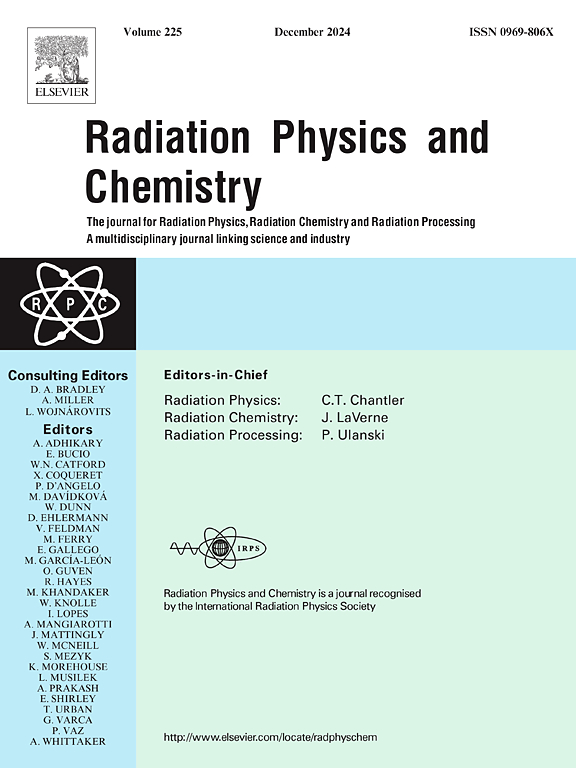Almana医院PET/CT中心患者脑PET/CT方案辐射暴露评估
IF 2.8
3区 物理与天体物理
Q3 CHEMISTRY, PHYSICAL
引用次数: 0
摘要
混合成像技术,特别是正电子发射断层扫描/计算机断层扫描(PET/CT),是确定原发性和转移性癌症的有效诊断工具。患者和工作人员在手术过程中可能会受到大量辐射。因此,对辐射防护的重视和安全评估的关键作用怎么强调都不为过。这些评估不仅仅是一种形式,而是遵守国际准则、确保所有相关人员的安全和福祉的必要步骤。这项研究评估了诊断过程中患者受到的辐射,并量化了辐射风险估计值。17 名患者接受了脑 PET-CT 方案评估。根据测量到的放射性和正电子发射断层扫描/计算机断层扫描(GE PET/CT VCT)设备中与联合 CT 相连的剂量,计算出患者的估计暴露量。脑 PET-CT 的平均施用放射性活度(AA)为 321.03 ± 51.49 mCi,范围为 222-436.6 mCi。有效剂量为 6.094 ± 0.98 mSv,范围在 4.21 至 8.29 mSv 之间。CT 程序的 DLP 和 CTDIvol (mGy) 平均值和范围分别为 1053.01 ± 384.32 (191.17-1845.92) 和 10.05 ± 4.34 (7.37-25.86)。目前患者所接受的辐射剂量略高于之前的研究报告。CT 占患者有效剂量的 58%。因此,优化照射参数和使用尽可能低剂量的 18F-FDG 将降低实际剂量值。本文章由计算机程序翻译,如有差异,请以英文原文为准。
Evaluation of Patient radiation exposure from brain PET/CT protocol at a PET/CT center in Almana hospital
Hybrid imaging technology, specifically Positron Emission Tomography/Computed Tomography (PET/CT), is an effective diagnostic tool for identifying primary and metastatic cancers. Patients and staff may experience significant exposure during the procedure. Therefore, the emphasis on radiation protection and the crucial role of safety assessments cannot be overstated. These assessments are not just a formality but a necessary step for adherence to international guidelines, ensuring the safety and well-being of all involved. This study assesses patient exposure during diagnosis and quantifies radiation risk estimates. Seventeen patients were evaluated using the brain PET-CT protocol. The estimated patient exposure was calculated based on the measured radioactivity and the dose linked to the combined CT in the Positron Emission Tomography/Computed Tomography (GE PET/CT VCT) device. The mean administered activity (AA) for Brain PET-CT was 321.03 ± 51.49 mCi, with a range of 222–436.6 mCi. The effective dose was 6.094 ± 0.98 mSv, ranging from 4.21 to 8.29 mSv. The mean and range of DLP and CTDIvol (mGy) for the CT procedure were 1053.01 ± 384.32 (191.17–1845.92) and 10.05 ± 4.34 (7.37–25.86), respectively. The current radiation doses given to patients are slightly greater than those reported in previous studies. CT constitutes 58 % of the patient's effective dose. Therefore, optimizing exposure parameters and using the lowest possible dose of 18F-FDG will reduce the practical dose value.
求助全文
通过发布文献求助,成功后即可免费获取论文全文。
去求助
来源期刊

Radiation Physics and Chemistry
化学-核科学技术
CiteScore
5.60
自引率
17.20%
发文量
574
审稿时长
12 weeks
期刊介绍:
Radiation Physics and Chemistry is a multidisciplinary journal that provides a medium for publication of substantial and original papers, reviews, and short communications which focus on research and developments involving ionizing radiation in radiation physics, radiation chemistry and radiation processing.
The journal aims to publish papers with significance to an international audience, containing substantial novelty and scientific impact. The Editors reserve the rights to reject, with or without external review, papers that do not meet these criteria. This could include papers that are very similar to previous publications, only with changed target substrates, employed materials, analyzed sites and experimental methods, report results without presenting new insights and/or hypothesis testing, or do not focus on the radiation effects.
 求助内容:
求助内容: 应助结果提醒方式:
应助结果提醒方式:


